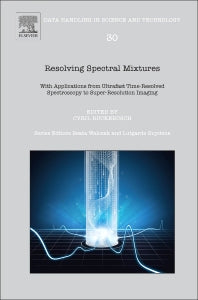Freshly Printed - allow 10 days lead
Couldn't load pickup availability
Resolving Spectral Mixtures
With Applications from Ultrafast Time-Resolved Spectroscopy to Super-Resolution Imaging
This comprehensive book presents an interdisciplinary approach to demonstrate how and why data analysis, signal processing, and chemometrics are essential to resolving the spectral unmixing problem
Cyril Ruckebusch (Volume editor)
9780444636386, Elsevier Science
Hardback, published 8 September 2016
674 pages
22.9 x 15.1 x 3.6 cm, 0.83 kg
Resolving Spectral Mixtures: With Applications from Ultrafast Time-Resolved Spectroscopy to Superresolution Imaging offers a comprehensive look into the most important models and frameworks essential to resolving the spectral unmixing problem—from multivariate curve resolution and multi-way analysis to Bayesian positive source separation and nonlinear unmixing. Unravelling total spectral data into the contributions from individual unknown components with limited prior information is a complex problem that has attracted continuous interest for almost four decades. Spectral unmixing is a topic of interest in statistics, chemometrics, signal processing, and image analysis. For decades, researchers from these fields were often unaware of the work in other disciplines due to their different scientific and technical backgrounds and interest in different objects or samples. This led to the development of quite different approaches to solving the same problem. This multi-authored book will bridge the gap between disciplines with contributions from a number of well-known and strongly active chemometric and signal processing research groups. Among chemists, multivariate curve resolution methods are preferred to extract information about the nature, amount, and location in time (process) and space (imaging and microscopy) of chemical constituents in complex samples. In signal processing, assumptions are usually around statistical independence of the extracted components. However, the chapters include the complexity of the spectral data to be unmixed as well as dimensionality and size of the data sets. Advanced spectroscopy is the key thread linking the different chapters. Applications cover a large part of the electromagnetic spectrum. Time-resolution ranges from femtosecond to second in process spectroscopy and spatial resolution covers the submicronic to macroscopic scale in hyperspectral imaging.
1. Introduction 2. Multivariate Curve Resolution-Alternating Least Squares for Spectroscopic Data 3. Spectral Unmixing Using the Concept of Pure Variables 4. Ambiguities in Multivariate Curve Resolution 5. On the Analysis and Computation of the Area of Feasible Solutions for Two-, Three-, and Four-Component Systems 6. Linear and Nonlinear Unmixing in Hyperspectral Imaging 7. Independent Components Analysis: Theory and Applications 8. Bayesian Positive Source Separation for Spectral Mixture Analysis 9. Multivariate Curve Resolution of Wavelet Compressed Data 10. Chemometric Resolution of Complex Higher Order Chromatographic Data with Spectral Detection 11. Multivariate Curve Resolution of (Ultra)Fast Photoinduced Process Spectroscopy Data 12. Experimental and Data Analytical Approaches to Automating Multivariate Curve Resolution in the Analysis of Hyperspectral Images 13. Multiresolution Analysis and Chemometrics for Pattern Enhancement and Resolution in Spectral Signals and Images 14. A Smoothness Constraint in Multivariate Curve Resolution-Alternating Least Squares of Spectroscopy Data 15. Super-Resolution in Vibrational Spectroscopy: From Multiple Low-Resolution Images to High-Resolution Images 16. Multivariate Curve Resolution for Magnetic Resonance Image Analysis: Applications in Prostate Cancer Biomarkers Development 17. Endmember Library Approaches to Resolve Spectral Mixing Problems in Remotely Sensed Data: Potential, Challenges, and Applications 18. Spectral–Spatial Unmixing Approaches in Hyperspectral VNIR/SWIR Imaging 19. Sparse-Based Modeling of Hyperspectral Data
Subject Areas: Enterprise software [UFL], Spectrum analysis, spectrochemistry, mass spectrometry [PNFS], Medical bioinformatics [MBF]


